Matched Sets:
There are variations in any manufactured product, this is especially true in tubes. What matching does is pair up tubes that are equal in potential. Typically, we're talking about Output Tubes, although there is a need for matching in driver tubes. By using matched sets, you get an equal amount of output voltage swing and current driving capability from each side of the push-pull audio transformer.
To try to visualize this: picture each of your hands as an output tube. Put your hands together like you are praying, only with a sheet of paper in between your hands; that's the speaker. Now push from
side to side. Notice that the speaker moves to either side of center. Now what happens if one of your arms is made to push harder? Your weak tube gets beat up, and the strong one has to work harder, try it. Lots of people match output tubes and do a very good job of it. Its expensive to do, in labor and electricity, and its worth it for you because in the not so long run its cheaper.
Matching tubes can also entail BURN-IN time. This addresses "infant mortality". Infant mortality describes the effect of most parts that will fail prematurely will do so in the first 24 to 48 hours of use. What burn-in is, is simply putting a device (tube) under conditions that resemble an actual circuit, and let it sit there and run. Then you test it to see if still works. If it does, two things happened:
1) The future reliability of that same tube went way up.
2) The BIAS POINT of the tube drifted. Again, you get a more reliable tube, because it wont need to be readjusted two days after you put the new tube in! Read more about bias.
